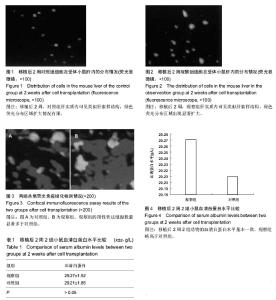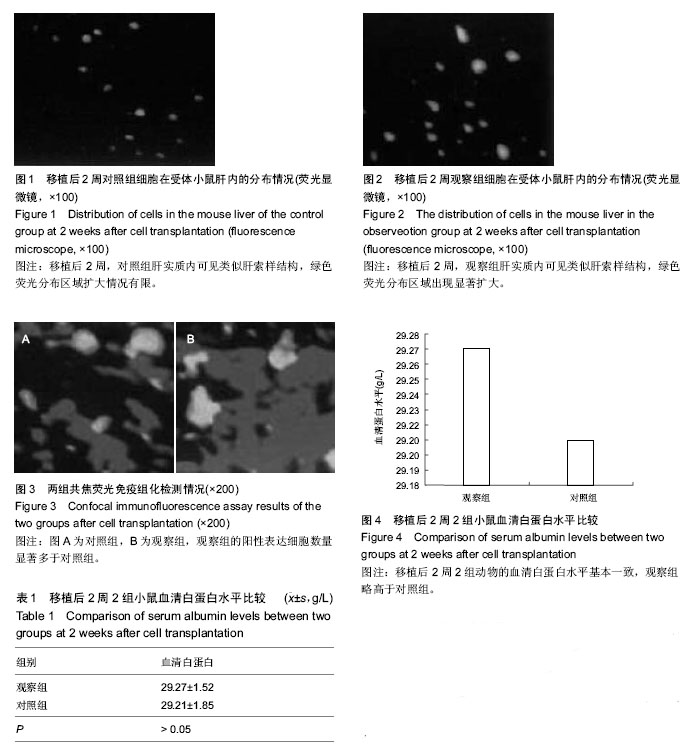| [1] 黄絮,叶波平,王大勇,等.肝干细胞及相关因子在肝再生过程中作用的研究进展[J].东南大学学报(医学版),2007, 26(3):241-242.[2] 蔡云峰,陈积圣,闵军,等.骨髓源性肝干细胞定向分化及脾内移植研究[J].中华实验外科杂志,2004,21(5):551- 553.[3] 路国勇,寸向农,杨开明,等.肝干细胞微环境在肝再生中的介导作用[J].四川解剖学杂志,2012,20(4):58-60. [4] Huang HP,Yu CY,Chen HF et al.Factors from human embryonic stem cell-derived fibroblast-like cells promote topology-dependent hepatic differentiation in primate embryonic and induced pluripotent stem cells. J Biol Chem. 2010;285(43):33510-33519.[5] 邓小耿,宋尔卫,闵军,等.胚胎干细胞源性肝干细胞肝内移植对宿主肝功能的影响及安全性评估[J].中国组织工程研究与临床康复,2008,12(8):1591-1595.[6] 裴海云,王韫芳,裴雪涛,等.胚胎干细胞向肝系细胞定向分化及其在肝再生中的应用[J].科学通报,2007,52(20): 2341-2347.[7] Heo J,Ahn EK, Jeong HG, et al. Transcriptional characterization of Wnt pathway during sequential hepatic differentiation of human embryonic stem cells and adipose tissue-derived stem cells. Biochem Biophys Res Commun. 2013;434(2):235-240.[8] 邓小耿,宋尔卫,闵军,等.胚胎干细胞源性肝干细胞在治疗性肝再生中的应用[J].中国病理生理杂志,2007,23(7): 1322-1325.[9] Shao CH, Chen SL, Dong TF, et al. Transplantation of bone marrow-derived mesenchymal stem cells after regional hepatic irradiation ameliorates thioacetamide-induced liver fibrosis in rats. J Surg Res. 2014;186(1):408-416.[10] Augustine TN,Kramer B.Signals from pancreatic mesoderm influence the expression of a pancreatic phenotype in hepatic stem-like cell line PHeSC-A2 in vitro: a preliminary study. Acta Histochemica. 2011; 113(3):349-352.[11] Li W, Jiang H, Feng JM, et al. Isogenic mesenchymal stem cells transplantation improves a rat model of chronic aristolochic acid nephropathy via upregulation of hepatic growth factor and downregulation of transforming growth factor β1. Mol Cell Biochem. 2012;368(1/2):137-145.[12] 邓小耿.胚胎干细胞中肝干细胞的筛选及在治疗性肝再生中的应用[D].中山大学,2004.[13] 王鹤桦,潘兴华,庞荣清,等.骨髓造血干细胞与肝再生的相关性研究[J].世界华人消化杂志,2004,12(12):2842- 2844.[14] Chan KM, Fu YH, Wu TJ, et al. Hepatic stellate cells promote the differentiation of embryonic stem cell-derived definitive endodermal cells into hepatic progenitor cells. Hepatol Res. 2013;43(6):648-657.[15] 侯建彬,刘超,余先焕,等.大鼠骨髓来源肝干细胞的成瘤性[J].中国组织工程研究与临床康复,2010,14(6):1015- 1018.[16] Jung J, Choi JH, Lee Y, et al. Human placenta-derived mesenchymal stem cells promote hepatic regeneration in CCl4-injured rat liver model via increased autophagic mechanism. Stem Cells. 2013;31(8):1584- 1596.[17] Russo FP, Parola M.Stem and progenitor cells in liver regeneration and repair.Cytotherapy. 2011;13(2): 135-144.[18] Ding BS, Nolan DJ, Butler JM, et al.Inductive angiocrine signals from sinusoidal endothelium are required for liver regeneration. Nature. 2010;468(11): 310-315,121.[19] 周播江,钟翠平,顾云娣,等.肝再生大鼠血清诱导骨髓干细胞向肝细胞分化的实验研究[J].中华肝脏病杂志,2004, 12(12):730-733.[20] 王亚萍.鼠胎肝干细胞的体外分离培养及体内移植的实验性研究[D].南方医科大学,2013.[21] Schmelzle M, Duhme C, Junger W, et al.CD39 modulates hematopoietic stem cell recruitment and promotes liver regeneration in mice and humans after partial hepatectomy. Ann Surg. 2013;257(4):693-701.[22] Mukhopadhyay A. Perspective on liver regeneration by bone marrow-derived stem cells-A scientific realization or a paradox. Cytotherapy. 2013;15(8):881-892.[23] Strick Marchand H, Morosan S, Charneau P, et al. Bipotential mouse embryonic liver stem cell lines contribute to liver regeneration and differentiate as bile ducts and hepatocytes. Proc Natl Acad Sci U S A. 2004;101(22):8360-8365.[24] Wilson JW,Leduc EH.Role of cholangioles in restoration of the liver of the mouse after dietary injury. J Pathol Bacteriol. 1958;76:441-449.[25] 赵利峰,徐存拴.肝干细胞的生长和分化与大鼠肝再生的相关性分析[J].解剖学报,2008,39(4):526-530.[26] 南雪,王韫芳,裴雪涛,等.肝干细胞及其在肝再生医学中的应用[J].自然科学进展,2005,15(2):129-133.[27] Schwerfeld-Bohr J, Chi H, Worm K, et al. Influence of hematopoietic stem cell-derived hepatocytes on liver regeneration after sex-mismatched liver transplantation in humans. J Invest Surg. 2012; 25(4):220-226.[28] Cho JW, Lee CY, Ko Y, et al. Therapeutic potential of mesenchymal stem cells overexpressing human forkhead box A2 gene in the regeneration of damaged liver tissues.J Gastroenterol Hepatol. 201;27(8):1362- 1370.[29] Du Z, Wei C, Yan J, et al. Mesenchymal stem cells overexpressing C-X-C chemokine receptor type 4 improve early liver regeneration of small-for-size liver grafts. Liver Transpl. 2013;19(2):215-225.[30] 刘峰,潘孝本,陈国栋,等.粒细胞集落刺激因子动员自体骨髓干细胞促进大鼠部分肝移植物的肝再生[J].中华医学杂志,2005,85(47):3342-3345.[31] 兰玲,陈源文,孙超,等.白细胞介素10基因修饰干细胞移植对肝纤维化大鼠肝脏炎症和肝再生的影响[J].中华肝脏病杂志,2009,17(12):915-920.[32] 潘兴华,陈系古,庞荣清,等.肝干细胞与肝再生、肝癌的关系[J].世界华人消化杂志,2004,12(8):1925-1927.[33] 蔡云峰.骨髓源性肝干细胞的筛选、扩增及诱导分化的研究肝癌术后肝再生状态与肝癌复发关系的初步研究[D].中山大学,2006.[34] 刘晓珑,李波.干细胞移植用于肝再生治疗的相关研究进展[J].中国修复重建外科杂志,2007,21(2):184-187.[35] Vasanthan P, Gnanasegaran N, Govindasamy V, et al.Comparison of fetal bovine serum and human platelet lysate in cultivation and differentiation of dental pulp stem cells into hepatic lineage cells. Biochem Eng J. 2014;88:142-153.[36] Sun J, Yuan Y, Qin H, et al. Serum from hepatectomized rats induces the differentiation of adipose tissue mesenchymal stem cells into hepatocyte-like cells and upregulates the expression of hepatocyte growth factor and interleukin-6 in vitro. Int J Mol Med. 2013;31(3):667-675.[37] 李东良,何秀华,范敬静,等.骨髓动员与骨髓间充质干细胞移植促进极量肝切除大鼠肝再生作用的对照研究[J].解放军医学杂志,2014,39(8):595-600.[38] Jin G, Qiu G, Wu D, et al. Allogeneic bone marrow-derived mesenchymal stem cells attenuate hepatic ischemia-reperfusion injury by suppressing oxidative stress and inhibiting apoptosis in rats. Int J Mol Med. 2013;31(6):1395-1401.[39] Huch M, Dorrell C, Boj SF, et al.In vitro expansion of single Lgr5-+ liver stem cells induced by Wnt-driven regeneration. Nature. 2013;494(7436):247-250.[40] Ding BS, Cao ZW, Lis R, et al.Divergent angiocrine signals from vascular niche balance liver regeneration and fibrosis. Nature. 2014;505(7481):97-102. |

